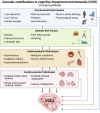Vascular cognitive impairment and dementia: An early career researcher perspective
- PMID: 35496373
- PMCID: PMC9043906
- DOI: 10.1002/dad2.12310
Vascular cognitive impairment and dementia: An early career researcher perspective
Abstract
The field of vascular contributions to cognitive impairment and dementia (VCID) is evolving rapidly. Research in VCID encompasses topics aiming to understand, prevent, and treat the detrimental effects of vascular disease burden in the human brain. In this perspective piece, early career researchers (ECRs) in the field provide an overview of VCID, discuss past and present efforts, and highlight priorities for future research. We emphasize the following critical points as the field progresses: (a) consolidate existing neuroimaging and fluid biomarkers, and establish their utility for pharmacological and non-pharmacological interventions; (b) develop new biomarkers, and new non-clinical models that better recapitulate vascular pathologies; (c) amplify access to emerging biomarker and imaging techniques; (d) validate findings from previous investigations in diverse populations, including those at higher risk of cognitive impairment (e.g., Black, Hispanic, and Indigenous populations); and (e) conduct randomized controlled trials within diverse populations with well-characterized vascular pathologies emphasizing clinically meaningful outcomes.
Keywords: VCID; early career researcher; vascular cognitive impairment; vascular dementia.
© 2022 The Authors. Alzheimer's & Dementia: Diagnosis, Assessment & Disease Monitoring published by Wiley Periodicals, LLC on behalf of Alzheimer's Association.
Conflict of interest statement
Nárlon C. Boa Sorte Silva, Oliver Bracko, Amy R. Nelson, Fabricio Ferreira de Oliveira, Lisa S. Robison, C. Elizabeth Shaaban have nothing to disclose. Atticus H. Hainsworth has received honoraria from Eli‐Lilly and from NIA, he is a member of the Vascular Cognitive Disorders PIA within ISTAART and he leads the UK Medical Research Council Dementias Platform UK (DPUK) Vascular Experimental Medicine group. Brittani R. Price is a full‐time employee of Life Molecular Imaging, GmbH.
Figures



References
-
- Zlokovic B V., Gottesman RF, Bernstein KE, et al. Vascular contributions to cognitive impairment and dementia (VCID): a report from the 2018 National Heart, Lung, and Blood Institute and National Institute of Neurological Disorders and Stroke Workshop. Alzheimer's Dement. 2020;16:1714‐1733. - PubMed
-
- Azarpazhooh MR, Avan A, Cipriano LE, Munoz DG, Sposato LA, Hachinski V. Concomitant vascular and neurodegenerative pathologies double the risk of dementia. Alzheimer's Dement. 2018;14:148‐156. - PubMed
-
- Schneider JA, Arvanitakis Z, Bang W, Bennett DA. Mixed brain pathologies account for most dementia cases in community‐dwelling older persons. Neurology 2007;69:2197‐2204. - PubMed
-
- Smith E, Wright C. Etiology, clinical manifestations, and diagnosis of vascular dementia—UpToDate. UpToDate. 2020:1‐31.
Grants and funding
LinkOut - more resources
Full Text Sources
Miscellaneous
